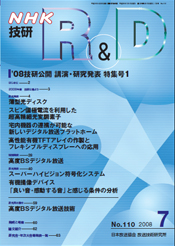
No.110 July 2008
Research Presentations
-
Thin Optical Disk
High-Data-Transfer-Rate Optical Recording Using High-Speed and Precise Beam-Positioning Control
Daiichi KOIDE↓summary- summary
- A thin optical disk with high-data-transfer-rate recording and a potential of large capacity has been investigated. The disk can rotate at a high speed of 15,000 rpm, which is beyond the current limit of 10,000 rpm in the Blu-ray Disk system. We have developed a new tracking control method, Zero Phase Error Tracking-Feed-Forward(ZPET-FF)control that can operate at 15,000 rpm on a thin optical disk system. We have successfully recorded random pattern data of 252 Mbps, the same as the data rate of broadcast-use HDTV VTR.
-
Ultra High Definition Light Modulation Device Driven by Spin Polarized Current
Kenichi AOSHIMA↓summary- summary
- We have proposed a new Magneto-Optic(MO)Light-Modulation(LM)device, which is driven by Spin-Transfer Switching(STS)using spin valves, and successfully demonstrated its basic operation. The proposed LM device has a possible spatial resolution of a few 100 nm, an order of magnitude smaller than conventional devices, and an ultra-high switching speed of a few nanoseconds. To improve the MO properties of LM devices, spin-valve films with perpendicular magnetic anisotropy were investigated, and we obtained thirty times larger MO properties compared to that with in-plane anisotropy.
-
New Digital Broadcasting Platform for Interaction with Home Network Devices
Akitsugu BABA↓summary- summary
- We are investigating a new digital broadcasting receiver platform for convenient content viewing, which communicates with other devices over the home network to utilize those functions. To this effect, we developed an interconnection method between devices on a network. From our results, we propose an extension of a Java-based data broadcasting standard, defined as ARIB STD-B23, toward advanced digital satellite broadcasting, which is expected to be launched in 2011.
-
Fabrication of High Performance Organic Thin Film Transistor Array and Its Application for Flexible Displays
Yoshihide FUJISAKI↓summary- summary
- Flexible displays, which are light weight, very thin and flexible, are expected to be suitable for receivers of advanced digital mobile broadcasting in the near future. Organic thin-film transistors(OTFT) with organic semiconductors are the most promising candidates as active driving devices for flexible displays because they are mechanically flexible and can be fabricated at a low temperature and low-cost. We have succeeded in fabricating a high performance OTFT array on plastic substrate by using a Ta2O5 gate insulator and an organic semiconductor. The array was applied to active-matrix flexible displays, and moving color images were successively displayed.
-
The Super Hi-Vision Codec System
Kazuhisa IGUCHI↓summary- summary
- NHK has developed an ultrahigh-definition television and has named it "Super Hi-Vision(SHV)". It has a 7,630*4,320 pixels video and 22.2-channel audio to provide viewers with"presence". We developed a codec system to make SHV service possible using broadcasting satellites. This codec system is based on the MPEG-4 AVC/H.264 video coding standard and the AAC audio coding standard. It can compress SHV video into 118 Mbps and SHV audio into 2 Mbps. In this paper, we describe the details of the codec system and introduce compression experiments.
-
Organic Image Sensor
Satoshi AIHARA↓summary- summary
- We have been developing a new type of image sensor overlaid with three organic photoconductive films, which are individually sensitive to only one of the primary color components(blue, green, or red), with the aim of developing a compact, high-resolution color camera without color separation optical systems used in current color cameras. We describe the unique characteristics of organic photoconductive films, such as wavelength selectivities and high resolution, and demonstrate color separation in a vertically stacked structure of three organic photoconductive films. These results show great potential for the development of high-resolution prism-less color cameras. A solid-state readout circuit overlaid with an organic film suitable for the sensor is also introduced.
-
Analysis of "Goodness" and "Kandoh"evoked by sound Evaluation Method of Sound Based on Kandoh
Satoshi OODE↓summary- summary
- The Japanese word "Kandoh" is defined as a "strong feeling when experiencing beautiful or wonderful things." Our main purpose was to evaluate next generation broadcast systems, particularly in terms of their sounds, from the viewpoint of Kandoh. First, we developed a questionnaire about Kandoh and collected words which expressed the situation of Kandoh from the answers. Furthermore, we calculated the distance between the words using similarity measures based on a subjective evaluation. The words were then categorized into 12 classes based on the distances. The evaluation scale of Kandoh was selected from each class and we could experimentally evaluate variations of Kandoh experiences.
-
Special Presentations/Advanced Satellite Digital Broadcasting System
Shoji TANAKA↓summary- summary
- Aiming at the launch in 2011 in Japan, the Association of Radio Industries and Businesses (ARIB) and the Information and Communications Council have been studying an advanced satellite broadcasting system, which employs state-of-the-art technologies and enables effective use of the entire spectrum and an introduction of new services. The advanced system has a number of new features; increased transmission capacity by the LDPC code and less roll-off factor, APSK modulations for a much higher capacity, higher resolution UHDTV and H.264|MPEG-4 AVC, super-surround sound and loss-less audio, Java-based data encoding, and transport of IP packets targeted for multimedia storage.

